This is the first in a series of personal reminiscences as told by “World Famous Tom Murphy.” You might look upon it as a peek into Tom’s Radio Diary. Tom Murphy is a legendary jock who had a storied career at several major market radio stations including: KISN-Portland; KJR & KOL-Seattle; WCFL, WMAQ & WRLL-Chicago; WIXY-Cleveland; WSAI-Cincinnati; KRLA, KFI and KIIS AM & FM-Los Angeles. Many of the photos and airchecks included here are from Tom’s personal collection. In this, Part 1 of a three installment series, Tom provides a first person insider description of ’91-derful!’ KISN’s skyrocketing success and the fiery crash at the end.
Tom’s friend and former colleague, Gary “Shannon” Burleigh in Seattle, assisted with this article. The editor is Steven L. Smith of QZVX.com.
The KISN Years (Part 1)
Don Burden, the FCC and the Rise and Fall of KISN Radio

Understanding Don Burden and his Star Stations
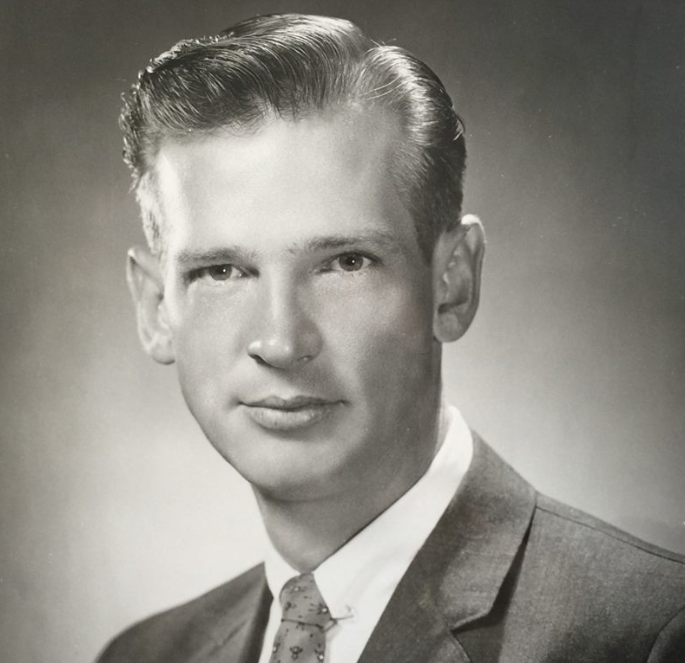
“Don Burden, President of the Star Stations, was brilliant at creating flame-throwing Top 40 radio stations. He wanted KISN to own the town. I remember his exact words: ‘We’re going to knock this market on its ass.’ He sure lived up to that statement, but the accompanying controversy was probably not part of his original plan. Don gave Portland, and the other cities where he owned stations, exciting, creative and great radio. Unfortunately his methods and personality led to strife and eventual disaster for his company.
“One of Burden’s friends and peers was fellow Top 40 radio innovator Gordon McClendon. Gordon built a communications empire with highly successful radio stations in Dallas, Houston, Chicago, Detroit, Los Angeles, San Francisco and several other large U.S. cities.

“Burden and McClendon were among the first broadcasters in the country to install the First generation of Collins cart machines. Cart machines came into being in the late 1950s when they were introduced by Collins Radio Company. For several decades thereafter, cart machines were standard control room equipment. This vintage ad below appeared in Broadcasting Magazine in 1959. It introduced to the radio world a new invention — the Collins cart machine.
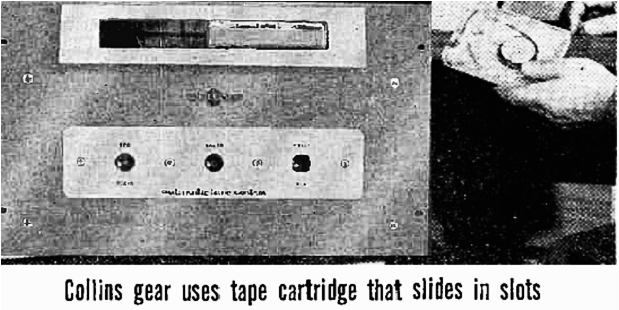
“At KISN, before Don brought in cart machines, we played our commercials from disks (records). Advertisers often provided ads already cut to disks. Other times spots arrived on reel to reel tape, which we would transfer to our own disks. Prior to the advent of cart machines, KISN jocks played music from 45 singles or 33 1/3 albums and our spots were also on 33 1/3 records. We cued up the ads on our studio turntables, the same way we played the music. After cart machines, KISN jingles, promos and commercials were always  dubbed to cart. For several more years, vinyl records remained our preferred media format for playing hit music. I know that before carts some radio stations ran their spots from reel to reel tape machines. Wow, fast forwarding and rewinding the tape had to be a real pain!
dubbed to cart. For several more years, vinyl records remained our preferred media format for playing hit music. I know that before carts some radio stations ran their spots from reel to reel tape machines. Wow, fast forwarding and rewinding the tape had to be a real pain!

“Here’s basic background information on the birth of KISN. Don Burden bought KVAN-AM, a station licensed to Vancouver WA, in March 1959. Then, on May 1 of that same year, KVAN became KISN. The early KISN air staff included Hal Raymond, Steve Brown, Jim Tate, Chris Lane (the PD who hired me), Dick Drury, Wally Thornton (aka J. Walter Beethoven) and Bill Jackson. The first two local Portland jocks hired to work KISN were Wally Thornton (Beethoven) and yours truly. My career at KISN began in June ’59 — only five weeks after Burden acquired KVAN. I was pretty inexperienced back then and at first they wanted me for weekends only. Three weeks later a full time opening came along and since I was ‘handy’ I got the job.
 “Up until Thanksgiving ’59, when the plush ‘KISN Corner’ studios and sales office opened in downtown Portland — occupying two floors at the corner of 10th and Burnside Streets — all of us jocks did our shows from the KVAN studios in Vancouver. I was the last guy to broadcast from that original KVAN studio.
“Up until Thanksgiving ’59, when the plush ‘KISN Corner’ studios and sales office opened in downtown Portland — occupying two floors at the corner of 10th and Burnside Streets — all of us jocks did our shows from the KVAN studios in Vancouver. I was the last guy to broadcast from that original KVAN studio.

“Since Burden was based in Omaha and I was a jock at his Portland station, we seldom saw one another. Despite Don being ensconced at corporate headquarters, the KISN staff always knew when he planned to visit Portland. There was a tip off or ‘tell’ as gamblers say: Don’s favorite secretary would rush out and get a new hairdo. If she had her hair done, Burden’s arrival was imminent. Since this lady was known to be Don’s internal spy at KISN, the rest of us on the staff maintained our distance but continually kept our eyes on her coiffure.
 “My contact with Burden was further limited by my schedule. When Don came to town, he was at KISN in the daytime. For most of my career at KISN, I worked an evening air shift and didn’t arrive at the station until late afternoon. By then Burden was heading off to the Benson Hotel for dinner and drinks….often lots of drinks as I recall. However, all of us jocks saw Don Burden sometimes. When he came to KISN, he inevitably scheduled Jock Meetings.’ Those meetings usually turned into memorable events. You might even use the word ‘spectacle.’ I think I should simply say that Don could be ‘very entertaining.’
“My contact with Burden was further limited by my schedule. When Don came to town, he was at KISN in the daytime. For most of my career at KISN, I worked an evening air shift and didn’t arrive at the station until late afternoon. By then Burden was heading off to the Benson Hotel for dinner and drinks….often lots of drinks as I recall. However, all of us jocks saw Don Burden sometimes. When he came to KISN, he inevitably scheduled Jock Meetings.’ Those meetings usually turned into memorable events. You might even use the word ‘spectacle.’ I think I should simply say that Don could be ‘very entertaining.’
“Burden traveled the country constantly — well beyond routinely commuting between the Star Stations. His strategy was to listen to top radio stations in different markets and to incorporate their best ideas (exceptional format ideas and promotional creativity) into his own stations. Burden was considered a great radio strategist. That photo of Burden, inserted into the above paragraph, was part of a feature story on Don in Broadcasting Magazine. He was reported to be ‘ahead in the formula game.’ This clipping dates back to August ’59 — shortly after KVAN morphed into KISN.
“Detractors can say what they want to about Don Burden, but the man wasn’t afraid to spend money to dominate ratings. A great example was when KISN, as part of the celebration of the station’s 5th Anniversary on May 1, 1964, ran a $91,000 promotional cash giveaway. Or consider this, at one point Don would purchase every jingle package that was pitched to him — even if he didn’t like the jingles and when he knew they’d never be played. His strategy was to buy up all of the available product. In that way he could deprive other stations of jingles. Now that is a ‘competitor!’ KISN was always known for aggressive promotions and clever marketing. Don Burden put his money where his mouth was.
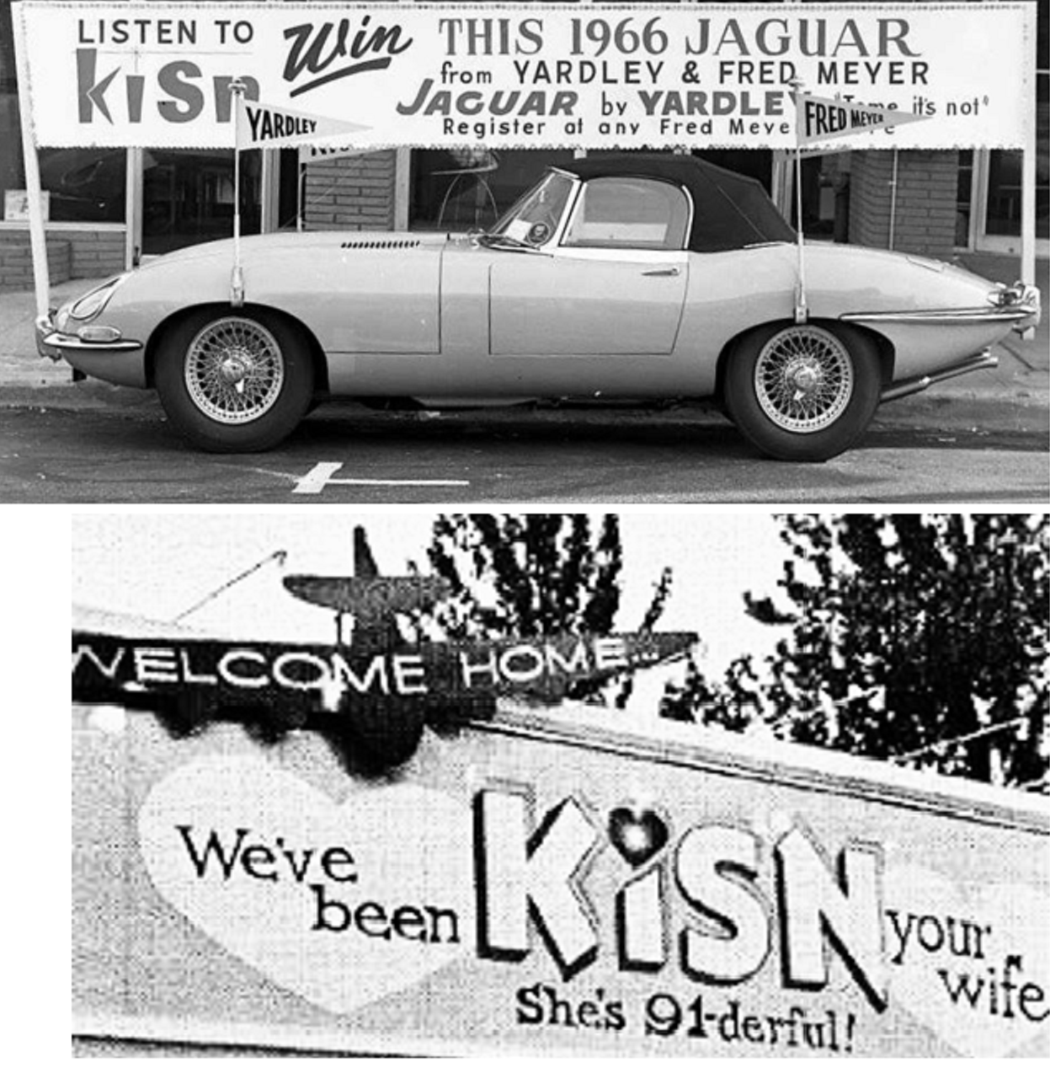
 “On a personal note, I recall that if Don liked you all was well in your world. I am happy to say he liked me. We were on a first name basis. I never called him ‘Mr. Burden’ or ‘boss.’ It was always just ‘Don.’ I still remember an awkward but humorous interaction with Don. One day he critiqued the way I read, or shall I say interpreted, the KISN liners. Remember that Burden was never known for his diplomacy. He said: ‘Tom you read the liners verbatim, yet somehow you still manage to make them sound like s__t.’ I replied: ‘Well Don, I guess it’s just a gift.’
“On a personal note, I recall that if Don liked you all was well in your world. I am happy to say he liked me. We were on a first name basis. I never called him ‘Mr. Burden’ or ‘boss.’ It was always just ‘Don.’ I still remember an awkward but humorous interaction with Don. One day he critiqued the way I read, or shall I say interpreted, the KISN liners. Remember that Burden was never known for his diplomacy. He said: ‘Tom you read the liners verbatim, yet somehow you still manage to make them sound like s__t.’ I replied: ‘Well Don, I guess it’s just a gift.’
Uncle Sam Came Knocking
“In January ‘62, while I was at KISN, a notice arrived by mail telling me to report for an Armed Forces induction physical. Excellent specimen that I was, I passed the physical. That meant I had a window of a few months in which to join a branch of the military or to end up drafted into the U.S. Army for two-years. If I voluntarily joined the Army, recruiters couldn’t commit to placing me in Armed Forces Radio — which is where I wanted to be. With the clock ticking and the draft lurking, I needed more options. A friend of mine was in the Oregon Air National Guard. He suggested I check out the Guard. I did so, it fit my lifestyle, and I enlisted.
“The Guard was a part time gig with a six-year commitment. It worked out exceptionally well for me. I mentioned earlier that Don Burden liked me. He proved it back then. When I was on active duty (basic training with the Guard in Texas), Don paid me half of my weekly salary for about four months. That was really good of him and the paycheck came in handy.

Burden’s Politics, the Radio Business & the FCC
“Burden had all the money he could ever need, but Don was fascinated by power and its inner workings. That is why he loved being seen with, and hanging out with, influential politicians. I guess it’s not surprising that when the Star Stations eventually lost their FCC licenses, Don’s relationships with politicians became a big part of his problem. He was accused of many improprieties including concealing political donations and gifts to both Oregon Governor, later U.S. Senator, Mark Hatfield and Indiana Senator Vance Hartke.
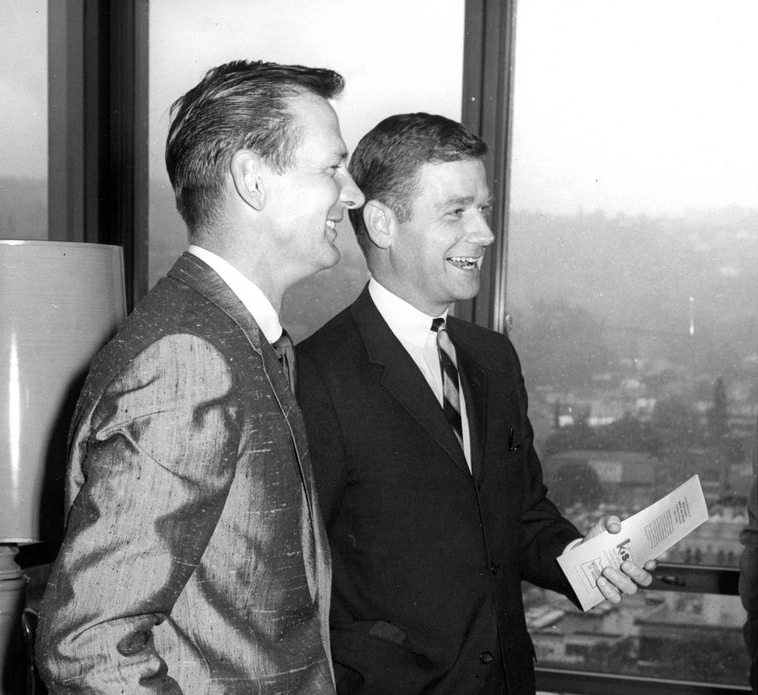
“Burden vehemently denied intentional wrong doing, but the FCC investigated Star Stations for multiple violations: slanting the news/political favoritism, deceptive billing, faulty bookkeeping, hyping ratings, rigging some contests and misrepresenting facts during the ensuing legal process. The Star Stations’ story has been told many times before, so let’s just say the FCC ultimately concluded that Burden was guilty of ‘pervasive and continuing misconduct’ and that he lacked the ‘requisite qualifications’ to remain a licensee. After several years of hearings and appeals, all of the Star Stations (KISN-Portland, KOIL AM/FM-Omaha, and WIFE AM/FM-Indianapolis) were shut down by the government in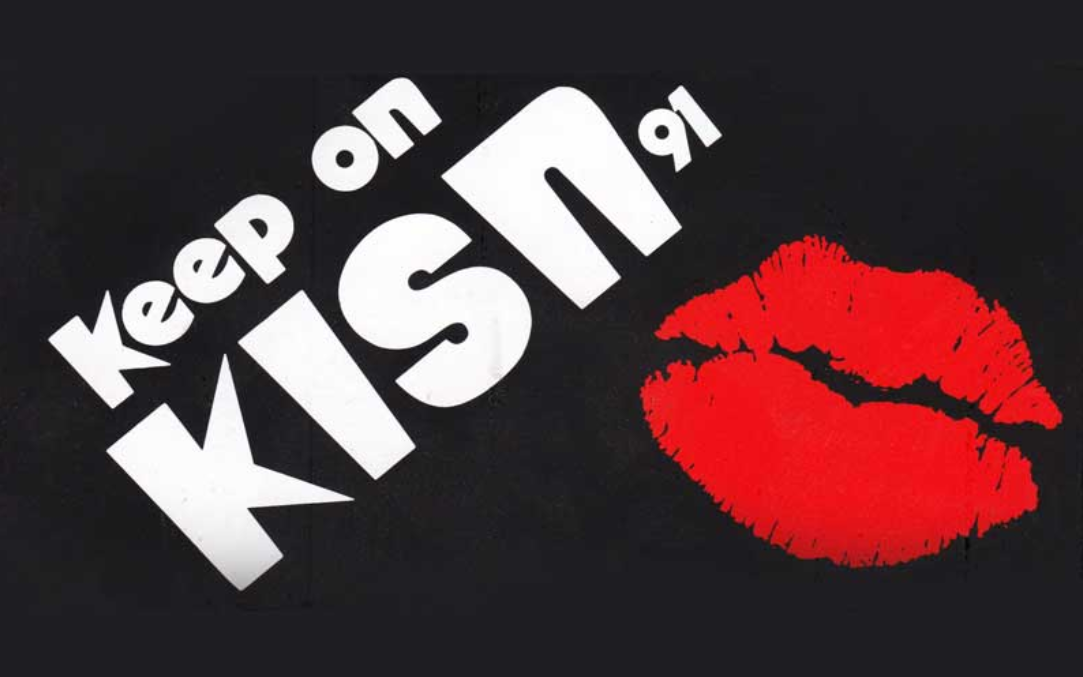 September 1976. Click here for additional information on the demise of the Star Stations.
September 1976. Click here for additional information on the demise of the Star Stations.
“I was more than a decade removed from KISN when the hammer came crashing down. But employees who were at the station during the final days, told me Don’s FCC attorney bragged that he was the greatest FCC attorney in D.C. Supposedly he had the connections to persuade the commission to drop all charges against the Star Stations. Obviously, it turns out the guy was wrong and he couldn’t.
“What I saw in my years at KISN paled in comparison to the mayhem that followed. However, I was at the station when it committed its original FCC sin: management’s attempt to bury the Vancouver, WA city of license ID. Don wanted the KISN call letters to be synonymous with the larger metropolitan city of Portland, OR — not the smaller city of Vancouver (across the Columbia River from Portland). That first highly publicized FCC fine, involving our station IDs, was first reported in 1962.”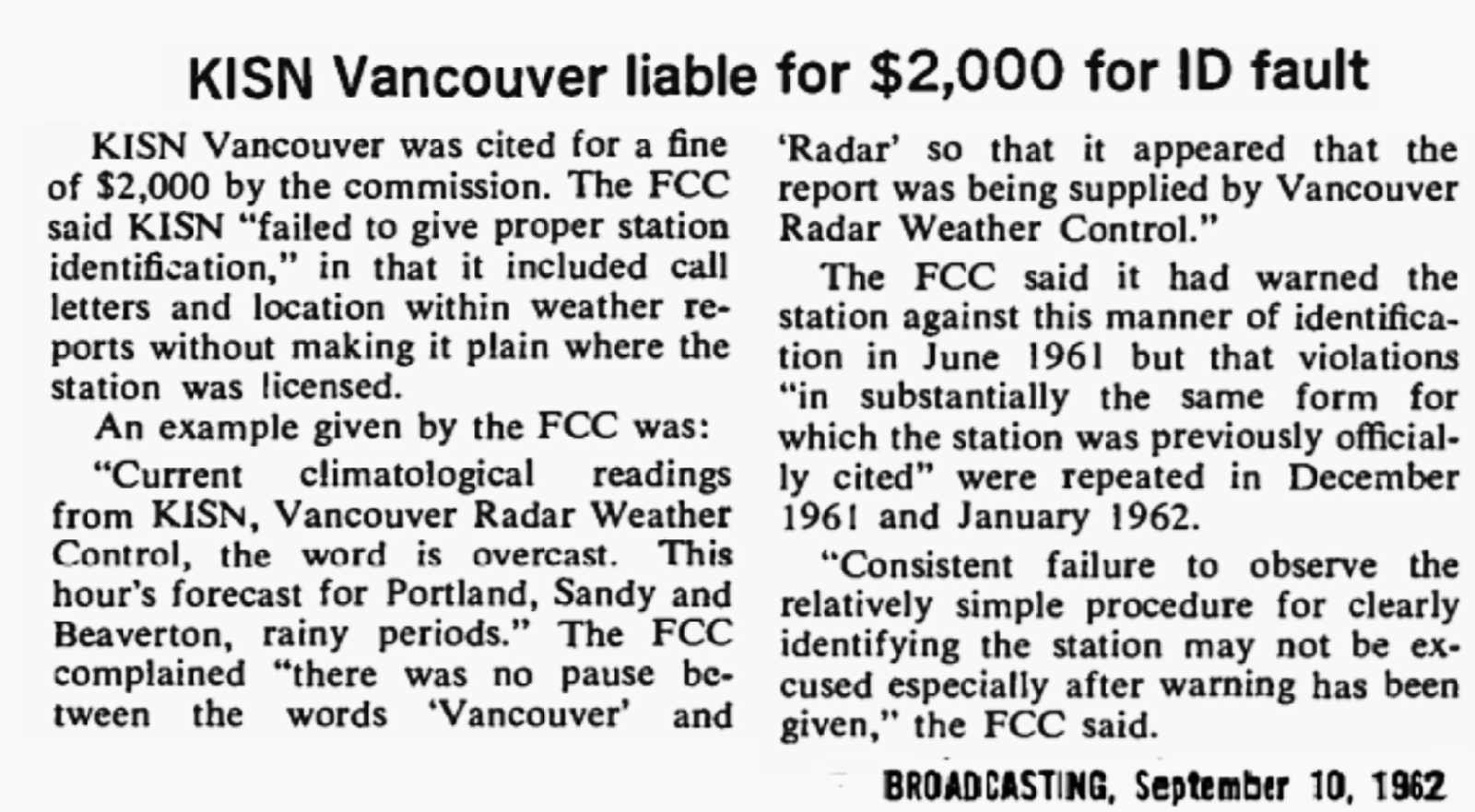
Editor’s note: Burden admitted to the violation, but he argued the problem didn’t “cause harm” to any other station or “corrupt the morals” of the community. It wasn’t any single incident that led to the $2000 fine. The FCC’s big issue with KISN was the station’s ongoing and pervasive effort to identify closely with Portland while downplaying city of license Vancouver, WA.
QZVX has collected a number of vintage KISN IDs, promos, and jingles. These date from years both before and after the FCC fine. In listening to these tracks, note that the bold and distinctly Portland flavored IDs and promos (pre-FCC fine in fall of ’62) melded into variations of “This is KISN, serving the Oregon Territory from Vancouver.” Tom will give us the inside story on that shortly.
Evolution of the KISN ID: 1959-Hal Raymond & John Doe; 1959-Tom Murphy & Loren Hassett; 1964-Real Don Steele show; 1967-John Drury & Tom Michaels; 1967-Bill Howlett, 1968-Roger W. Morgan; 1969-Pat Pattee (Nightwatch); 1970-Whitey Coker & Buddy Scott (Run Time 4:10)
Trying to Satisfy the FCC
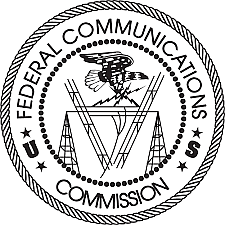 “Since KISN wasn‘t a network station, 51% of our local programming was supposed to originate from a main studio in city of license Vancouver, WA. For purposes of appeasing the FCC, Burden designated the original KVAN/KISN transmitter site at Smith Lake in North Portland as the main studio. The 10th and Burnside downtown Portland studio was legally the remote studio and a sales office. Jocks, or operators as the FCC called them, in the downtown studio were responsible for remotely taking and entering transmitter meter readings into the operating log. That was standard procedure at radio stations where
“Since KISN wasn‘t a network station, 51% of our local programming was supposed to originate from a main studio in city of license Vancouver, WA. For purposes of appeasing the FCC, Burden designated the original KVAN/KISN transmitter site at Smith Lake in North Portland as the main studio. The 10th and Burnside downtown Portland studio was legally the remote studio and a sales office. Jocks, or operators as the FCC called them, in the downtown studio were responsible for remotely taking and entering transmitter meter readings into the operating log. That was standard procedure at radio stations where  the studio and the transmitter were separate from one another (See the late fifties ‘Gates’ ad promoting remote control equipment of that era.) Then in 1962, the same year they issued a fine for the KISN IDs, the FCC conducted a surprise inspection at the downtown Portland remote studio. FCC Inspectors found that some KISN transmitter readings were not accurately logged, and/or readings were not entered every 30 minutes as was mandated by law. Such problems were not uncommon in the radio industry, after all most jocks considered themselves to be entertainers and not radio engineers or operators. Regardless, when the commission identified discrepancies in logging procedures at KISN, that typically small issue became yet another reason for the FCC to pursue Burden and his radio stations.
the studio and the transmitter were separate from one another (See the late fifties ‘Gates’ ad promoting remote control equipment of that era.) Then in 1962, the same year they issued a fine for the KISN IDs, the FCC conducted a surprise inspection at the downtown Portland remote studio. FCC Inspectors found that some KISN transmitter readings were not accurately logged, and/or readings were not entered every 30 minutes as was mandated by law. Such problems were not uncommon in the radio industry, after all most jocks considered themselves to be entertainers and not radio engineers or operators. Regardless, when the commission identified discrepancies in logging procedures at KISN, that typically small issue became yet another reason for the FCC to pursue Burden and his radio stations.
“Whenever anyone asks me if I had an inkling that my employer might have been engaging in risky or unethical business practices, the answer is ‘NO.’ Remember, the real serious trouble — the alleged political situations that ultimately killed the Star Stations began in ’66 — a year after I had departed KISN. I obviously knew about the FCC’s problem with our operating logs, and all of the jocks were aware of the FCC’s attempt to force KISN to position itself less with Portland and more with Vancouver. Yet I don’t recall any big push on the part of management to make KISN a ‘Vancouver’ station.

“Don’t get me wrong, it’s not that KISN totally ignored the FCC’s complaints. But the most identifiable management response to the 1962 FCC investigation was to dispatch jocks to the transmitter site. Granted, we also modified the wording on the station IDs. As you heard in the sound clip above, we changed the ID to ‘KISN, serving the Oregon Territory from Vancouver.’ That ID must have been palatable to the FCC, because it endured for many years. Caveat, and please don’t tell the FCC, but although we modified the wording of the legal ID, we did not necessarily do so on our jingles, drop-ins and promos. We still maintained the Portland connection wherever and however we could.
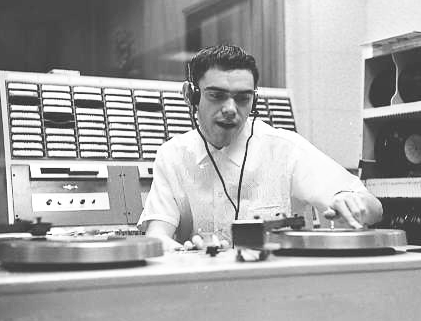
“I certainly won’t imply that I totally escaped all of the drama with the FCC. Before I go there, let’s examine my status in the early sixties: It is undisputed, at least in my humble opinion, that The Wonderful Tiger Tom Murphy Show was six hours of edge of your seat thrills and excitement. That said, here’s how the FCC’s 51% local programming requirement (as I described above) impacted me. Pat Pattee, the overnight DJ, always originated his show from the transmitter site. And the evening newsmen, first Loren Hassett until he was replaced by Bill Howlett, did their newscasts and headlines from the transmitter. All that made a decent ‘start’ toward achieving 51% local content, but it was not nearly enough.
“You probably see where this is going: I had a lengthy six-hour daily air shift, so management dispatched me to the transmitter site. I didn’t like the plan, but transferring me to the transmitter significantly added toward KISN’s goal of fulfilling the FCC’s magic number of 51% local programming.

“Although I loved working side by side with my newsman buddy Bill Howlett at the transmitter site, before long I knew I didn’t want to be posted out there anymore. After faithfully trekking to the transmitter for six or seven months, I had decided that ‘enough was enough!’ I needed to get Burden’s attention and I did so by resigning from KISN. Shortly after, he called and scheduled a meeting with me. Don said we would discuss my resignation and any grievances I had with the station. For example, despite my maintaining the highest ratings on KISN, I hadn’t had a pay raise in a long time. When I met with Burden, I explained that the most people (pedestrians and cars) went by the KISN window in the evening. It just flat wasn’t smart marketing to have an empty studio window at a peak traffic time. Obviously, KISN’s popular evening personality (me) should’ve been sitting in that corner window. Burden listened intently and he agreed with what I said. We came to an equitable resolution — a generous increased salary for me and no further obligations on my part at the transmitter site.
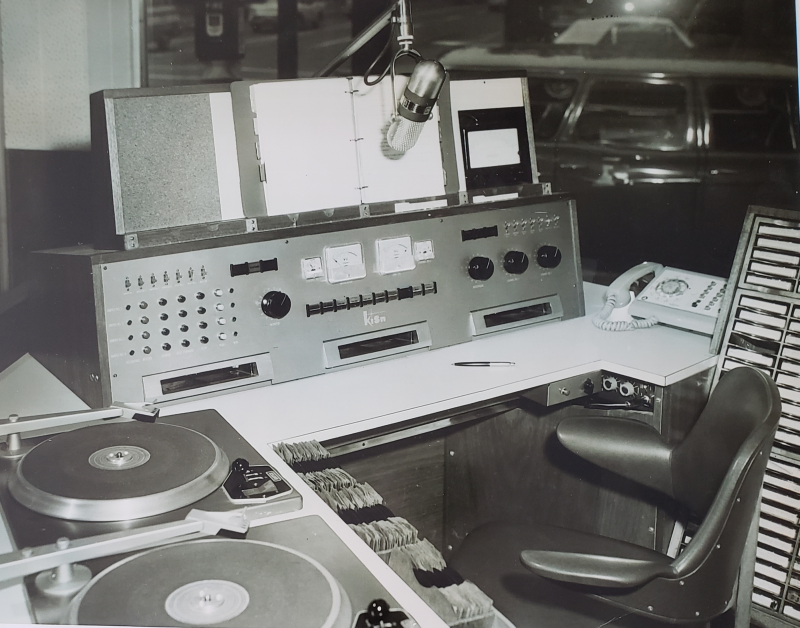
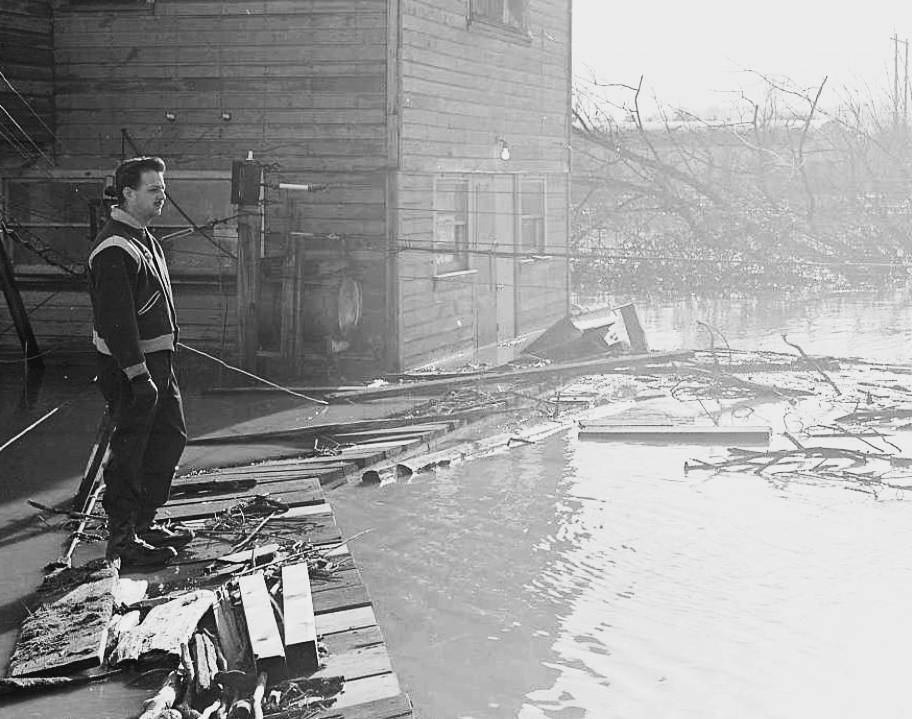
“As I think back on my having to trudge out to the transmitter on a daily basis, I am reminded of a funny story involving The Real Don Steele. Since it was situated at Smith Lake, the transmitter site would occasionally flood. At least once it flooded for a few days at a time and air staff assigned there had to go in and out by boat. Lucky for me, I was never in that position.
“But I know taking the boat wasn’t a fun and relaxing voyage. Sometimes a few snakes would get in the boat. Hold that thought. In the meantime, let me explain that Real Don Steele did his Sunday evening show from the transmitter. When KISN switcheroo a directional pattern at night, a First Phone Operator had to be on duty at the transmitter. Pat Pattee and Bill Howlett, who always did their shifts from the transmitter, had First Phone Licenses. And Don did too! So when he went solo from the transmitter at night, KISN saved money — no need to hire another First Phone to keep the station legal. As a bonus, Real Don’s broadcasts from the transmitter helped us edge toward that elusive goal of 51% local programming.
“Except, when the transmitter site was flooded, we discovered a snafu with the overall plan. It turned out that Don Steele, or ‘The Emperor’ as he often called himself, had zero tolerance for snakes — they totally freaked him out. The only time I know of that Steele had to take the boat, he was forced to ride share with a few snakes writhing in the bottom of the boat. After his shift was over, I was waiting for him at the downtown studio. We often went out for dinner, be it the middle of the night or not, after his shift. As I waited that night, suddenly an excited and always flamboyant Real Don Steele burst through the door yelling: ‘Hey Baby!!! There were f*****g snakes in the f****g boat, Baby!!!!’

“Since I am discussing The Real Don Steele, let me describe what it was like to work with him. He was lots of fun. For sure Don was a guy you would remember for a lifetime. He loved doing afternoon drive and that shift suited his style — fast talking, loud, with a high-octane delivery. Real Don Steele owned afternoons in Portland. Me, well I was accustomed to doing evenings. Then one day Real Don, KISN’s PD at the time, told me that as of May 1, 1964 he intended to move me to morning drive. That change coincided with KISN’s big 5th Anniversary (Birthday) and the $91,000 Giveaway. The Emperor himself even promoted me on-air as the funniest morning DJ in the world.” (Editor’s note: You can hear Real Don Steele’s promo for Tom’s morning show in the upcoming section on KISN’s Flying Car.)
“My morning shift duties lasted for a few months but, as a result of personnel and scheduling changes, I went back to evenings in September of the same year. But that brief morning shift at KISN was a precursor of things to come. It is true that when I went to KJR in ’65, initially they hired me for the evening shift. But in the fall of ’68, KJR management moved me to afternoons. From that point forward, after KJR, I always worked mornings or afternoons — no more evening shifts.” (Editor’s note: Tom was a key player at Channel 95 during KJR’s Golden Years.)
“I want to say more about my friend, the late Bill Howlett. I mentioned previously that an upside of my time spent at the transmitter was working closely with Bill.
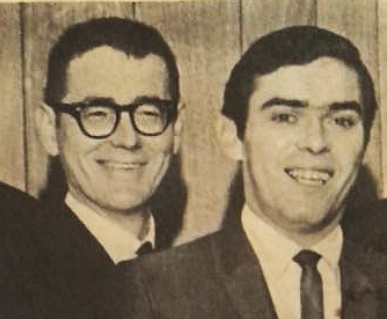
“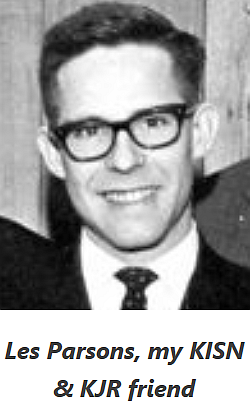 My friendship and personal relationship with Bill was such that we collaborated on several creative ventures over the years. In fall of ’61, even before we worked together at the transmitter, we developed a radio comedy series called ‘Meet Your Neighbor.’ The theme revolved around goings on in the neighborhood. It consisted of 28 so-called interviews with all different people such as Basil Stupendaponte movie producer, Webley Hemmingspoon the bird watcher, Flip Feeny..the donut dunking champion…..Anselmo Perrywinkle the fashion designer for House of Gertrude…and 24 other make believe folks. The idea for ‘Meet Your Neighbor’ was mine and then Bill took over. He wrote the scripts for the majority of the episodes. I provided most of the character’s voices and Bill was usually the interviewer. We were proud of these funny and fictitious interviews. Recently I was >pleased to learn that Les Parsons, a friend of mine from both KISN and KJR, told Gary ‘Shannon’ Burleigh that he ‘holds in high regard’ the ‘Meet Your Neighbor’ comedy sketches. That compliment, coming from a real pro like Les, means a lot to me.
My friendship and personal relationship with Bill was such that we collaborated on several creative ventures over the years. In fall of ’61, even before we worked together at the transmitter, we developed a radio comedy series called ‘Meet Your Neighbor.’ The theme revolved around goings on in the neighborhood. It consisted of 28 so-called interviews with all different people such as Basil Stupendaponte movie producer, Webley Hemmingspoon the bird watcher, Flip Feeny..the donut dunking champion…..Anselmo Perrywinkle the fashion designer for House of Gertrude…and 24 other make believe folks. The idea for ‘Meet Your Neighbor’ was mine and then Bill took over. He wrote the scripts for the majority of the episodes. I provided most of the character’s voices and Bill was usually the interviewer. We were proud of these funny and fictitious interviews. Recently I was >pleased to learn that Les Parsons, a friend of mine from both KISN and KJR, told Gary ‘Shannon’ Burleigh that he ‘holds in high regard’ the ‘Meet Your Neighbor’ comedy sketches. That compliment, coming from a real pro like Les, means a lot to me.
I have kept recordings of all of the original ‘Meet Your Neighbor’ series and will periodically release them at QZVX. But for now, below you can listen to a couple of my favorite episodes.”
Meet Your Neighbor – The Speech Therapist and The Folk Singer, includes vintage clips of Tom as a jock in the early sixties. (Run Time 6:36) Editor’s note: Personally, I think ‘Speech Therapist’ is really funny!
KISN’s Flying Car
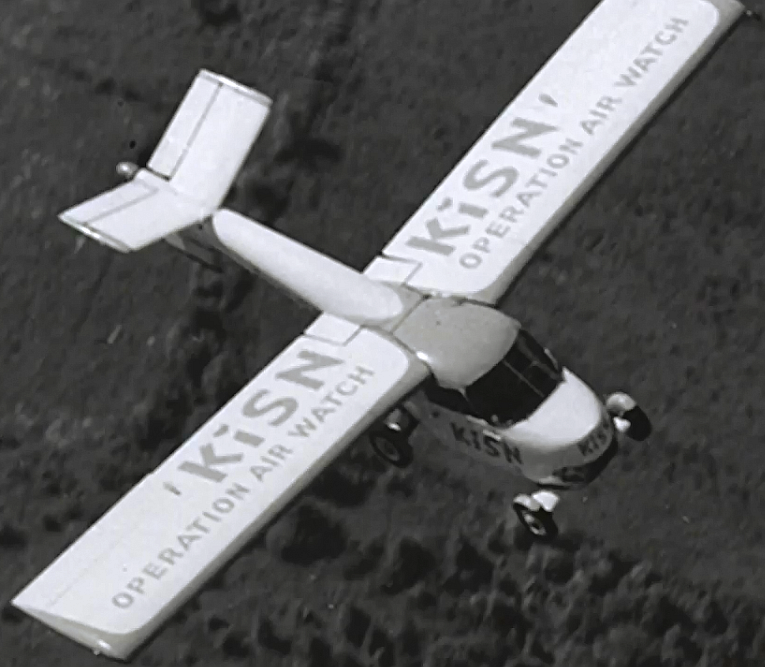
“From 1961 until 1963, the KISN Airwatch featured live traffic reports from the KISN Aerocar. Now the Aerocar was an exclusive, something other stations didn’t have. Only six Aerocars were ever built and KISN was the only radio station that had one.
“The contraption was invented by a man from Longview, WA, which isn’t far from Portland. It looked like a clunky car, but when the wings were extended it became a clunky aircraft. Our Aerocar was painted white with red hearts and it had the KISN calls on the top and bottom sides of the wings. The thing would go 60 MPH on land (car mode) and top air speed was 110 MPH. There were a few different Airwatch pilots, but the best known was Scotty Wright. He logged 350 hours in the Aerocar. Let me be honest about it: I don’t have fond memories of the Aerocar. In my opinion, it was a death trap. Thank God the damn thing never crashed. In those days, I wasn’t known for always making smart decisions. But my refusal to go up in the Aerocar had to be among my wisest decisions. And on that note, I will end my remarks in this installment, Part 1, of the KISN Years. That’s it for now…. later, Tom signing off.”

Editor’s note: Out of the half-dozen Aerocars that had been built, three of them crashed. When Burden became aware of those grim statistics, he grounded the KISN Aerocar — even though it had been highly visible and integral to the station’s promotions. Tom’s response to viewing the two Aerocar photos was: “Now you can probably see why I wouldn’t join Scotty Wright for a thrill a minute flight over The City of Roses.”
The audio cut, below the photo of pilot Scotty Wright in the cockpit, is fun listening. It’s from The Real Don Steele show. You’ll hear Scotty calling in his airborne traffic reports. Steele’s comments, directed back at Scotty, were clever and humorous. Don was emphatic that Scotty should refer to Portland’s old ‘Steel’ Bridge as ‘The Real Don Steele’ Bridge.

Real Don Steele show with Scotty Wright flying the Aerocar, 1964. This track includes some really cool and classy station promos. (Run time 3:41)
QZVX is pleased to announce that more stories from Tom Murphy will be coming your way soon. In Part 2 and 3 of ‘The KISN Years,’ Tom will share his memories of radio legend The Real Don Steele and discuss the “Tina Delgado is Alive!!!” phenomenon that began at KISN. Many of Tom’s well-known colleagues and friends from the KISN years will be featured: Paul Revere & The Raiders and their manager DJ Roger Hart; The Kingsmen, KISN announcers Tom Michaels and Johnny Williams; photographer extraordinaire Gino Rossi; and a woman Tom called “Contest Connie.”
The second installment of Tom Murphy’s Radio Diary is now available. It is full of information about radio and music legends he has known….lots of fun stuff! You can read Part 2 by clicking here.
And if you have already read Parts 1 & 2, you can read Part 3 (the story of Tom’s formative years from high school to KISN) by clicking here.
Credits and acknowledgments: Stumptown Blogger; KISN Good Guy Radio; PDX Media; DJ Master Control; Radio Disc Jockey.homestead.com; Gino Rossi photographer; Gary ‘Shannon’ Burleigh, Les Parsons and William Ogden

Memories of the “Mighty Ninety-One” persist….
I spent 8 years with KISN…and later went on to own it.
Bill Failing
I was hoping to find a photo of Jim Tate to show my grand daughter